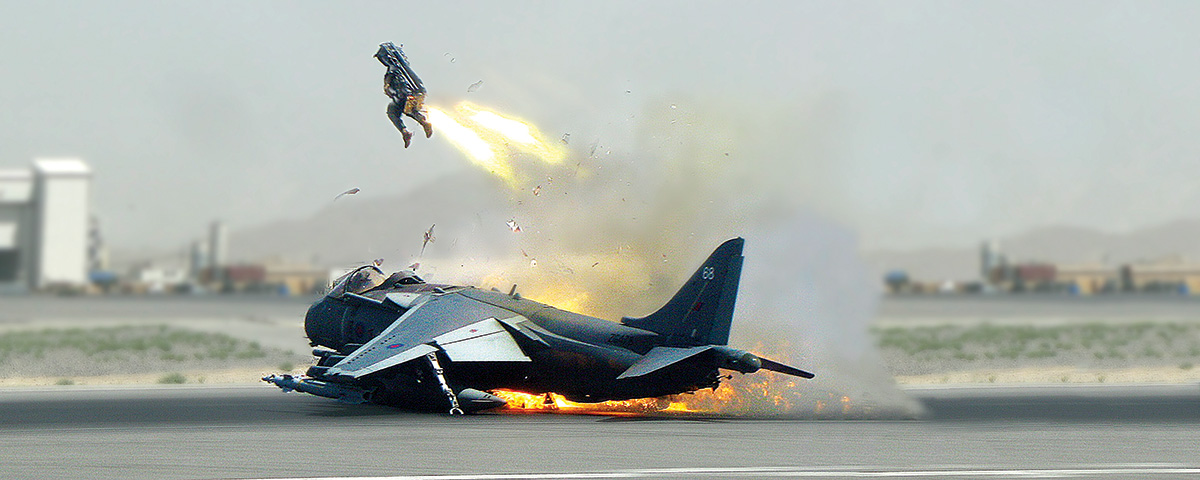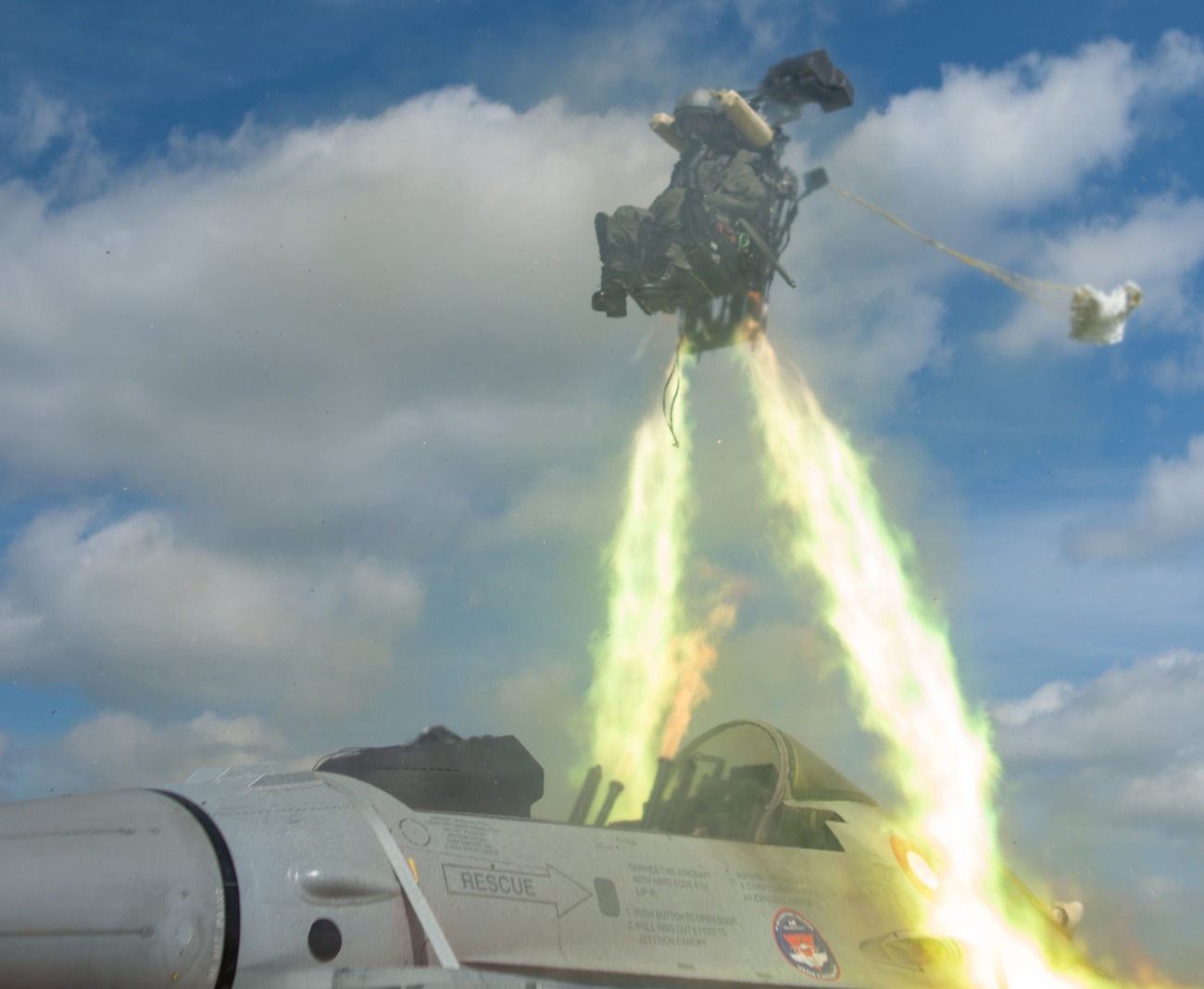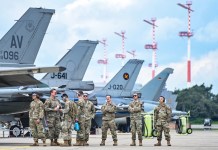India’s indigenous Light Combat Aircraft (LCA) Tejas encountered a mishap during a routine training sortie on March 12, resulting in a crash in Rajasthan’s Jaisalmer district. This incident marks the first crash of the Tejas jet since its inaugural flight on January 4, 2001, 23 years ago.
Despite the unforeseen mishap, the pilot managed to escape unscathed as the Martin-Baker IN16G Seat facilitated a successful ejection from the aircraft.
Martin Baker, known for its expertise in crafting ejection seats and aviation safety equipment, swiftly highlighted the effectiveness of its seat in ensuring the pilot’s safe exit.
The significance of ejection seats in military aircraft cannot be overstated. These sophisticated pieces of technology are meticulously engineered to provide a means of escape for pilots in emergencies, thereby minimizing the risk of casualties during unforeseen incidents.
From early experiments with propellant-driven seats to the introduction of rocket-propelled ejection mechanisms, innovations in this realm have revolutionized pilot safety, enabling ejections at supersonic speeds and lower altitudes.
The history of ejection seat development can be traced back to the early 1930s, with pioneering efforts undertaken in Germany and Sweden. The first documented instance of a successful pilot ejection occurred during World War II.
German Test pilot Helmut Schenk, flying the He-280, became the first person to utilize an ejection seat to escape from a malfunctioning aircraft in January 1942. The event marked a significant milestone in aviation history.
The Heinkel He 162A Spatz was the first operational military jet equipped with an ejection seat activated by an explosive cartridge. On the other hand, Martin-Baker emerged as the first major seat ejection company in the late 1940s, laying the groundwork for advancements in pilot safety.
In 1958, the Convair F-102 Delta Dagger became the first aircraft to feature a rocket-propelled ejection seat, enabling pilots to eject at supersonic speeds and lower altitudes. This technological advancement facilitated ejections at speeds exceeding 1,300 km/h, a capability demonstrated by six pilots.
Yet, a tragic accident on July 30, 1966, involving two Lockheed M-21 crew members, highlighted the risks inherent in high-speed ejections, with one member surviving and the other succumbing after both fell into the sea from an altitude of 80,000 ft.
Notwithstanding such incidents, most ejections occur at lower speeds and altitudes when pilots determine they cannot regain control of the aircraft before impact with the ground.
Deciphering The Mechanics Of Ejection Seats
First and foremost, pilots are trained to recognize specific verbal cues signaling the need for ejection. If the situation requires imminent ejection, the pilot may use the word “eject,” signaling the need to prepare for ejection within a certain timeframe.
However, in dire emergencies where an immediate exit is necessary, the command “Bailout! Bailout! Bailout!” is given.
Each crew member, whether pilot, co-pilot, or weapons systems officer, is equipped with a sizable parachute and harness that securely fastens into the seat of their respective aircraft.
When the pilot activates one or both of the two levers located on the sides of the seat, charges ignite to blow open the aircraft canopy, followed by rocket boosters propelling the entire seat, with the occupant, out of the jet.
Within moments, the individual should find themselves airborne, floating above the descending aircraft with a parachute canopy deployed overhead.

In modern two-seat aircraft, the ejection seats are synchronized, meaning that activating one seat triggers the other automatically. However, in older aircraft like the T-38, each crew member must initiate their ejection independently.
It is crucial for the co-pilot positioned in the rear seat to eject first to avoid being exposed to the rocket blasts from the pilot’s seat. After ejection, the seat separates from the occupant, and if conditions permit, the parachute deploys automatically at a low enough altitude. If all proceeds as planned, the individual should descend to the ground at a survivable speed.
Aircraft engineered for low-altitude operations may incorporate ejection seats that activate through the canopy, bypassing the slower process of canopy ejection. Zero-zero ejection seats are specifically designed to extract occupants safely from a stationary, grounded position with zero altitude and zero airspeed.
These seats utilize small rockets to propel upward to a sufficient altitude, followed by a small explosive charge to rapidly deploy the parachute canopy, ensuring a successful descent.
The entire sequence, from pulling the handle to the parachute opening, usually takes approximately 2.5 seconds. Maintenance of ejection seats, including checking the condition of cartridges and rockets, is crucial and is typically handled by specialized technicians.
The parachute plays a pivotal role in the ejection process. It is meticulously packed to ensure it deploys rapidly without the entanglement of rigging lines.
Risk To Pilot Life & Survival Probability
Fighter pilots undergo extensive training to view the ejection option as an absolute last resort. This approach is not only due to the high cost of combat aircraft but also because there’s no assurance that it won’t result in fatalities.
According to a report, each time the eject lever is pulled, there’s a one-in-three chance of sustaining a spinal injury.
However, as stated by David Newman, an aviation medicine researcher at Swinburne University and a former Royal Australian Air Force doctor with experience in civilian flights, this risk is preferable to the potential outcomes of crashing into the surface or experiencing a midair explosion. Consequently, Newman regards activating the ejection lever as an “escape mechanism of last resort.”
Indian Air Force Air Marshal Anil Chopra (Retired), purportedly the only Air Marshal globally to have ejected from a fighter aircraft while holding that rank, elaborated in his article for EurAsian Times that the force exerted during ejection typically remains within normal human physiological limits.
However, he cautioned that ejection injuries could result in significant bruising along the harness straps and potential collarbone fractures.
Chopra noted that spinal or neck injuries might occur due to incorrect body posture during ejection or inadequate back muscle strength. He emphasized the dangers of ejecting from an aircraft traveling at speeds exceeding the speed of sound (1,207 km/h).

The retired Air Marshal highlighted the perilous consequences of ejecting at such velocities, where the force experienced can exceed 20g, potentially causing injuries such as compression fractures of the vertebrae or shoulder injuries from a flayed arm.
Chopra also warned of possible lacerations or concussions during ejection resulting from collisions with the canopy or fuselage. Further, he underscored the risk of injuries during parachute landings due to poor posture upon impact or uneven terrain.
According to Chopra, ejecting below the designated minimum height specified for the seat could prove fatal. He explained that the final parachute descent to the ground occurs at a vertical velocity equivalent to a free-fall jump from a 12-foot height. Aircrews, he added, undergo training on how to cushion their landings to minimize the risk of injury.
There is a notable contrast in ejection survival rates based on altitude, with low-level ejections presenting a significantly heightened risk of fatal outcomes. Ejections occurring below 500 feet exhibited a survival rate of nearly 51%, whereas those above this threshold boasted a survival rate nearing 92%.
In a similar line, Patricia Marins, a Brazil-based defense expert, told the EurAsian Times the significant risk posed by ejection systems, particularly regarding vertebral fractures. Approximately 20-30% of individuals who manage to survive ejection suffer from spinal fractures.
When a pilot ejects from an aircraft, they are propelled upward by a rocket-powered ejection seat, experiencing forces equivalent to around 18 times their body weight.
The rapid acceleration, reaching speeds of 140 to 160 meters per second squared, subjects the spine to vertical compression, particularly affecting the thoracic and lumbar regions. This compression places considerable strain on the spinal column, increasing the likelihood of fractures and other injuries.
However, Marins noted that modern ejection seats, such as those found in fighter jets like the Gripen, are engineered specifically to reduce the risk of vertebral fractures. Despite its dangers, ejection seats boast a 92% survival rate, making the possibility of sustaining a spinal injury a risk worth taking to preserve one’s life.
A B-1 Bomber crew member who ejected over the Indian Ocean shared, “I lost a full inch in height.” This illustrates the physical toll that ejection can take. Yet, it underscores the sacrifice service members endure to assert air superiority and achieve supersonic flight.
Tragically, many aircrew members have hesitated to eject, leading to fatalities. These delays often stem from a combination of factors, including an inherent fear of ejection or a lingering hope of salvaging the aircraft from the dire situation. In some instances, mere seconds separate life from death.
To prepare aircrews for such critical moments, most air forces provide ejection training, which may include virtual reality simulations that echo parachute descent and post-ejection checklist procedures.
- Contact the author at ashishmichel(at)gmail.com
- Follow EurAsian Times on Google News




